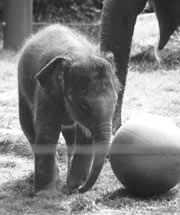Last Friday, one of Seattle’s biggest and (though most fans probably don’t know her name) best-loved celebrities left town. Named Chai, she weighs four and a half tons. She was born in Thailand 19 years ago and has lived at Woodland Park Zoo for 18. Because she’s the most easygoing of the zoo’s four elephants, Chai is known to thousands of children (and many shameless adults) as “that nice elephant” who parades out on weekends to be stroked and patted—a modern echo of the intimate 3,000-year working relationship between humans and their closest counterparts in life span and psychosocial development.
Two weeks after her farewell promenade, Chai entered a metal crate and was hoisted atop a flatbed for two days and nights—the first step toward what may prove a whole new life for her and the zoo’s centerpiece elephant exhibit. Before she left, however, the exhibit received a new arrival—a massive, motorized, cottage-sized steel cage called “an elephant restraining device” or “crush.” Together, its arrival and Chai’s departure signal much-debated changes in the way elephants are cared for on this continent and new turns in the struggle to save them from doom here and in their homelands.
Chai is now at another zoo in Springfield, Missouri, awaiting another sort of intimacy. With a measure of luck, she’ll mate with a six-and-a-half-ton bull named Onyx, return home, and after 22 months’ gestation deliver the first calf ever born in Seattle, and also the city’s first new elephant in 17 years. This matchmaking, undertaken after six years’ failed artificial insemination and much negotiation, is not just a bid to get the zoo an irresistible crowd magnet. It’s one more desperate gesture against extinction.
Human incursion has drastically reduced the Asian (or “true”) elephant’s territory and numbers. Where millions once roamed from Java to China to Syria, perhaps 25,000 now huddle in shrinking pockets of South and Southeast Asia. And elephants aren’t faring much better over here. Leaving aside those in circuses and roadside attractions, only 243 captive cows and 38 bulls make up the elephant North American Species Survival Plan. “Half of those males are juveniles born over here,” says Ken Morgan, an elephant keeper at Woodland Park. “So you have about 20 adult males, eight to 10 of which aren’t breeding for one reason or another.” That doesn’t leave much of a stud stock—and kidnapping young elephants from the wild is no longer permitted.
And what will those isolated captive-born bulls know when they grow up? Like humans, elephants are big-brained, long-lived, slow-maturing critters who ordinarily grow up in complex societies; rather than doing what comes instinctually, as lesser animals do, they must learn to woo, mother, and otherwise behave. Unschooled in family matters, captive cows are pained and confused at birth—”afraid of their babies,” says David Blasko of California’s Marine Land Africa USA, the past president of the Elephant Manager’s Association. Without help from wiser elephants or human surrogates, they sometimes kill their own or others’ newborns.
More bad news for would-be midwives: Elephant cows may breed into their fifties, but if they don’t by their midtwenties their fertility falls off. Two of Seattle’s elephants, Bamboo (who’s Asian, cranky, and 31) and Watoto (African, 29, and, because she’s the only one with tusks, domineering) have missed their chance.
After epic attempts at many zoos, artificial insemination has succeeded only twice—both times this summer, in Indianapolis. The successful sperm came from a bull on-site, and thus didn’t have to survive freezing and transport.
While many other species that have declined even more in the wild are multiplying in artificial “arks” like zoos, elephants are declining there as well. “Mortality is twice natality,” Morgan intones. “The population is collapsing around the world. It will be a long time before they become extinct, because they live so long. But all indications are they’re three generations away.”
And so Chai is making the costly, uncomfortable, and (as ever when you move someone as big as an elephant) dangerous trip to Missouri. Woodland Park would next seek a mate for its other young, Thai-born elephant, Sri (“See”). If either delivers a male, the zoo would try to keep it and take the line even further; its long-range plans call for building an elephant bullpen—no mean project, since males must be kept separate, in even stouter enclosures than females.
AND THAT’S WHERE THE CRUSH comes in. “Crush” is a misnomer that keepers disavow, then lapse into using; the motorized cage doesn’t squeeze the big beasts, it restrains them and, with adjustable bars and entries, makes feet and other parts available for care. Modeled on the stockades traditionally used to catch and train wild elephants, it is the essential tool of a growing, though much-debated, trend in zoo elephant care—toward hands-off “protected contact.”
Woodland Park and the majority of zoos still practice “free contact”: Keepers walk and talk amongst the giants, interacting somewhat as fellow, dominant herd members. That interaction takes many forms, from tender encouragement to prodding recalcitrant beasts and thumping their 8-inch-thick skulls with the hooked ankus. In protected contact, keepers never approach the elephants; they confine them in the crush for cleaning, medical care, and other emergencies. Elephants are trained to cooperate by “operant conditioning,” with tasty treats. Though he favors free contact, Blasko concedes that protected is better “from an insurance and liability standpoint.” Elephant handling is rated the country’s most dangerous profession, though Woodland Park’s chief elephant keeper, Patrick Maluy, says he knows of no insurance concerns here.
Protected contact also deflects animal-rights agitators and uneasy onlookers, who recoil at the prodding and occasional chaining under free contact. And even free-contact stalwarts like Morgan and Blasko concede that some elephants are just too dangerous for it—notably adult bulls, who go into a periodic raging state called musth.
Females also grow cranky in middle age and become attached to certain keepers. But keepers move around, and don’t live with their charges 24 hours a day as circus trainers did: “No one stays with a job more than three years,” laments Marine Land’s Blasko. That’s not been the case at Woodland Park, where the pay’s good, the keepers dedicated, and tragic human/elephant encounters unknown. Woodland Park’s temperamental Bamboo can’t abide many people. But she dotes on one keeper, Chuck Harke—who can retire in a year, though he intends to stay longer. Bamboo might live another 30. Maluy expects to someday end all free contact with her. To control her, then, means accustoming her to the restraining device now. Otherwise, he says it’s merely a backup “tool” for emergencies.
So far, it appears less than promising as a hope for elephants’ long-term survival. Beyond the satisfaction that humans, and apparently elephants, take from interacting across their species divide, free contact affords major practical benefits. It’s much less labor-intensive to train and manage elephants hands-on than through a Skinnerian cage. And it’s nearly essential to the effort to bring them back from the brink; breeding requires endless gynecological observation (and quantities of K-Y Jelly) before mating, and obstetric and pediatric aid after. Only one US zoo, in Houston, has attempted breeding within protected-contact bars—twice. One elephant mom (who’d had three young before) succeeded on her own. The other didn’t know what to do with her infant, which was promptly killed by another elephant. “The keepers stood by and watched,” recounts Blasko. “Under protected contact, they couldn’t go in.”







